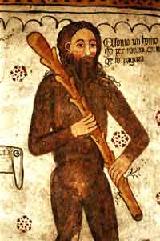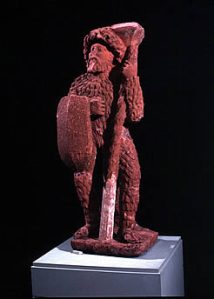Beginning in the 12th Century, Medieval Europe saw the Wodewose rise to fame in literature and art. From this time through the 16th Century the running theme of a wild man carrying a club was prevalent in tales and stories. Nowadays the debate over this creature seems to have three sides to it. Was it real? If so is it a Bigfoot? Or maybe a neanderthal?
The term derives from an Anglo-Saxon definition meaning “wood man” and later “man of the woods”. While brought into popularity during the 12th Century the origins appear to lie within Spain in the 9th Century. Written in a book is the story of a goddess who dresses like a wild man and participates in dances. This would appear to be the beginning of wild-man festivals (masquerades) which grew in popularity in the Middle Ages.
There are a couple curious clues about these Wodewose:
- They are never described as animals. No references to being ape-like or having more noticeable primate features. They are described as human. With more hair and not as sophisticated, but a man nonetheless.
- They were seen as people living on the fringes of society and just beyond the boundaries of civilization. In more ancient text it was written that wild men were at one with the nature of the forests they lived in. However this is not the case with Wodewose. They were described almost as outcasts or not permitted to be within the mainstream.
- They were depicted as capable of using tools such as clubs and spears
- They also had families which, when described, were given only human characteristics. Wild women and wild children were also seen as human.
One of the most popular encounters with a Wodewose can be found in a book from Norway around 1250 titled “King’s Mirror”.
“It once happened in that country (and this seems indeed strange) that a living creature was caught in the forest as to which no one could say definitely whether it was a man or some other animal; for no one could get a word from it or be sure that it understood human speech. It had the human shape, however, in every detail, both as to hands and face and feet; but the entire body was covered with hair as the beasts are, and down the back it had a long coarse mane like that of a horse, which fell to both sides and trailed along the ground when the creature stooped in walking.”
The most interesting thing about the Wodewose is the fact that in Medieval Europe not one reference is made about them in Historical documents. Nothing in letters, records, census reports, or other important documents. This leads some to speculate that they are completely fictional. However the flip side would be that if they were already described as man then there would be no need to mention how much hair one had on their body in official documents.
Theories about the Wodewose include:
- They were people who shunned society and through years of living in the forests grew extra hair for survival against the elements.
- They are Bigfoot’s cousin in Europe
- They are neanderthals
- They are the last remaining hunter/gatherer tribes in Europe
- They are purely fictional


